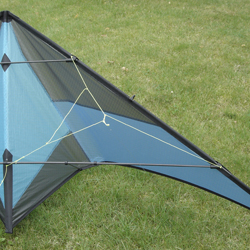Methods and terminology
Methods

There are two methods to make a bridle:
1. We can use the measures of an existing bridle.
2. Make a new design where we start with a base bridle. This is completely adjustable in all directions and can be fine tuned at the flying spot.
For this website-project we'll use a bridle that is well tested by experienced pilots. This bridle is absolutely best fit for the pilots who like to do tricks and fly freestyle with their Le Quartz.
Terminology
The bridle for this kite is composed out of 2 lengths of bridle line that are knotted at each side of the kite. Looking at the position on the kite, we call the parts like this: Upper leg, Lower leg, Inner leg, Pig tail and the Turbo.
Upper leg:
Is the top part of the bridle that connects to the frame above the upper APA-connector to the leading edge.
Lower leg:
Is the lower, outside part of the bridle that connects to the frame under the bottom APA-connector to the leading edge.
Inner leg:
Is the lower, inside part of the bridle that connects to the frame under the Central-T to the spine.
Pig tail:
Is the little piece that connects the bridle with the flying lines. It's in the shape of a loop and has a fat knot on the end (where we connect the flying lines with a Prussic knot). The connection with the bridle is at the Inner leg.
Turbo:
is a part of the Inner leg between the connection point of the Pig Tail and the place where the Inner Leg is knotted to the upper/lower leg.
Activator leg:
is a piece of bridle line that connects between the Inner leg and the Upper leg, mainly to prevent the bridle to get stuck behind the tail of the kite. An added benefit is that it activates the other line when flying tight bends or sharp corners.
For those of you who want to learn more about bridles and all the effects tuning can have, there are two very good websites on this subject:
Ian Newhams website
Andy Wardley's Website
|